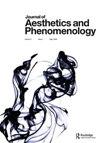Gestures, Attunements and Atmospheres: On Photography and Urban Space
IF 0.2
0 PHILOSOPHY
引用次数: 0
Abstract
ABSTRACT Developed through a series of conceptual analyses (Edmund Husserl, Vilém Flusser, Ludwig Wittgenstein and Walter Benjamin) and case studies (Fernando Lopes’s Belarmino and Jeff Wall’s Mimic), this article delves into the relationship between gesture, attunement and atmosphere and how it unfolds in photographic works dealing with urban space. The first section focuses on the role played by photography in the film Belarmino, which raises questions about both the representation of urban phenomena and issues related to expression and gesture in boxing. The second section discusses Husserl’s thinking on image consciousness and his surprising reference to a “photograph” of a boxer, which reveals the relevance of his phenomenological approach when it comes to defining the aesthetic properties of gesture-images. The third section examines the principles of Flusser’s philosophy of gestures, focusing on the semantic field of attunement and its connection with various elements related to photography, gesture, moods and affects. The question of gesture in photography—both the gestures of the photographed and those of the photographer—can be articulated with the notions of attunement and atmosphere, which go beyond semiological, psychological and communicational approaches and are important for our understanding of aesthetic and artistic experiences. Finally, if photography is a privileged way of studying atmospheres and gestures (as suggested by the Benjaminian notion of optical unconscious) and their connection with the inner life of the subject, in relation to urban space this study often acquires an intersubjective, social and political dimension, as in Jeff Wall’s Mimic.姿态、调音与氛围:论摄影与城市空间
本文通过一系列的概念分析(埃德蒙·胡塞尔、维尔卡姆·弗卢瑟、路德维希·维特根斯坦和瓦尔特·本雅明)和案例研究(费尔南多·洛佩斯的《贝拉米诺》和杰夫·沃尔的《模仿》),深入探讨了姿态、调和和氛围之间的关系,以及这种关系如何在处理城市空间的摄影作品中展开。第一部分主要关注摄影在电影《Belarmino》中所扮演的角色,它提出了关于城市现象的表现以及与拳击中的表达和手势相关的问题。第二部分讨论胡塞尔关于形象意识的思考和他对拳击手“照片”的惊人引用,这揭示了他的现象学方法在定义手势图像的美学属性时的相关性。第三部分考察了弗卢瑟手势哲学的原则,重点是调谐的语义场及其与摄影、手势、情绪和情感相关的各种元素的联系。摄影中的手势问题——无论是被拍照者的手势还是摄影师的手势——都可以用调音和气氛的概念来表达,这超越了符号学、心理学和交流的方法,对我们理解审美和艺术体验很重要。最后,如果摄影是研究氛围和姿态的一种特权方式(正如本杰明的光学无意识概念所暗示的那样),以及它们与主体内心生活的联系,那么在城市空间方面,这种研究往往获得主体间性、社会和政治维度,就像杰夫·沃尔的《模仿》一样。
本文章由计算机程序翻译,如有差异,请以英文原文为准。
求助全文
约1分钟内获得全文
求助全文

 求助内容:
求助内容: 应助结果提醒方式:
应助结果提醒方式:


